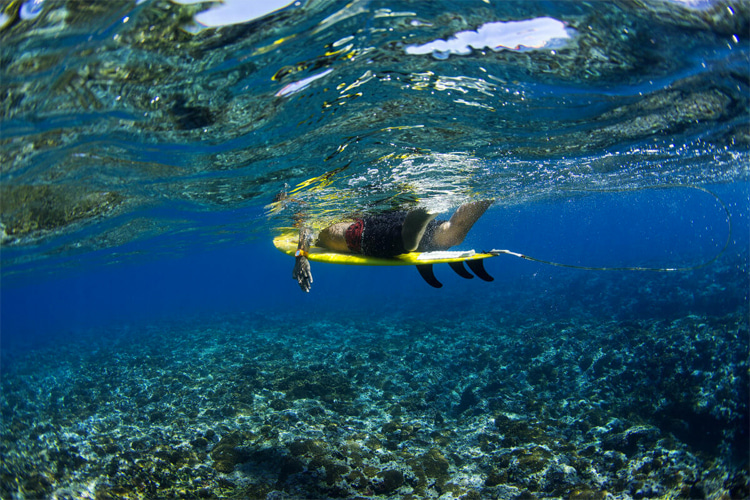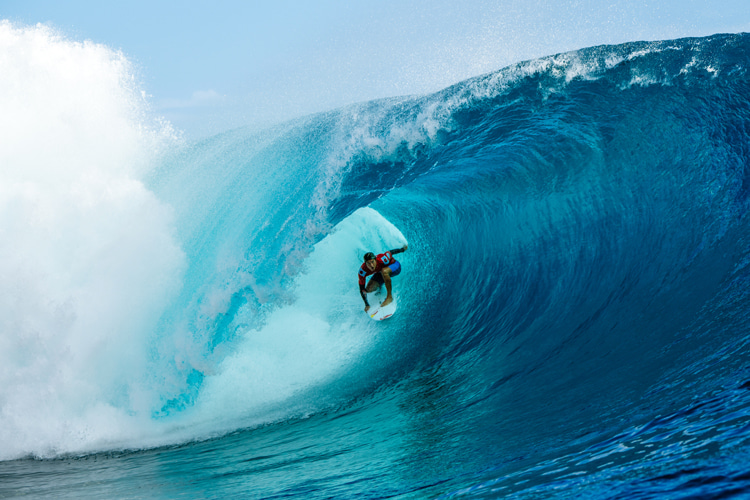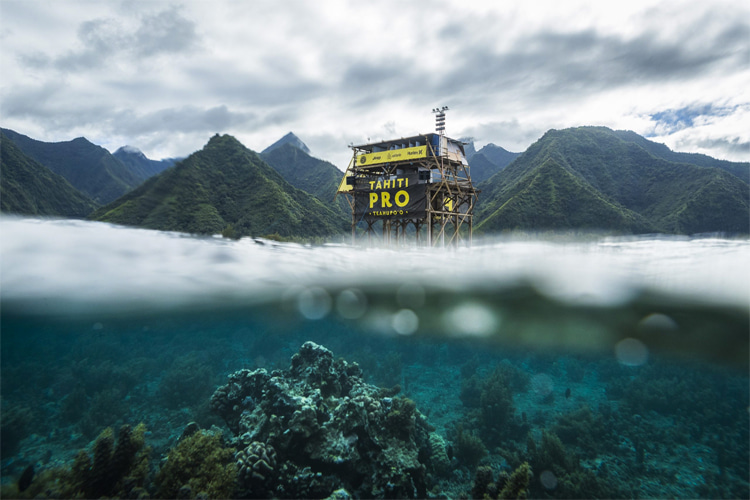Teahupoo is a magical place and a truly unique playground for surfers.
The small Tahitian village, known for hosting some of the world's most spectacularly dangerous waves, is currently at the center of a brewing storm.
The surf events for the Paris 2024 Olympics, which will take place more than 9,770 miles (15,700 kilometers) away from the iconic Eiffel Tower, are slated to be held on its pristine, legendary reef break.
But as the waves roll in, so does the controversy over a pricey aluminum structure that threatens the village's cherished environment.
A Tale of Two Towers
For years, a beloved wooden tower has stood sentinel at Teahupoo.
This age-old structure has offered a vantage point for countless Tahiti Pro camera operators and judges.
However, the Paris 2024 Olympic organizers have ambitious plans to replace this with a more permanent aluminum scaffolding with a staggering price tag of $5 million (€4.6 million).
Supporters argue that the new structure is necessary.
The Olympics will host a larger audience than the typical World Surf League (WSL) events, and, as reported by The Guardian, "For the Olympics, the platform may need to accommodate up to 40 people."
The problem, the locals stress, is that this could potentially endanger the fragile lagoons' coral reef.

Local Voices Rise in Protest
Not all are on board with this architectural transition.
Many of the 1,500 local residents have made their feelings known, going so far as to organize a protest march from the marina to the point.
Leading the charge on social media is Tahitian surfer Matahi Drollet. Taking to Instagram, he proclaimed, "This peaceful walk is not against the Olympic Games, but against the new aluminum judging tower they want to build on the reef."
Expressing his concerns for the environment, he noted the potential for damage to the "reef and the whole ecosystem of the lagoon in front of the wave… and in the worst case scenario, the wave of Teahupoo also."
Drollet further emphasized the community's deep connection with its waters, stating, "The ocean and the lagoon is the most precious place we have here."
"This is where we get our food from, where we play, where we spend most of our time, and where we have the most perfect wave in the world."
"It's a heritage of our ancestors that we need to preserve."
Echoing this sentiment is Cindy Otcenasek, President of the environmental defense association Vai Ara o Teahupoo.
She voiced concerns about the proposed 103-cabin cruise ship accommodation for athletes and staff, noting it "is not the best solution - the motors run all day - but it's the one that won't leave any lasting trace in Teahupoo."
Olympic Assurances Meet Skepticism
The Paris Olympic organizers, keenly aware of global scrutiny and local concern, assert that the environmental disturbance will be minimal.
Their official website confidently promises that "the small-scale overlay installations set up for the Games will disappear after the competition."
But there's a twist. Hidden in their commitment is an exception concerning the new judges' tower.
This structure, unlike others, is intended to remain post-Games to potentially host other significant surfing events.

Teahupoo Reef Uniqueness
The Teahupoo wave breaks over a very shallow semi-circular coral reef, around 20 inches (51 centimeters) deep.
This shallowness, combined with the reef's unique shape, plays a significant role in the formation of the wave.
The coral at Teahupoo is known to be razor-sharp.
Surfers who wipe out risk serious injuries, with many receiving cuts and abrasions if they come in contact with the reef.
This makes surfing Teahupoo especially perilous.
One of the standout characteristics of the Teahupoo reef is the sudden transition from deep to shallow waters.
The ocean floor goes from a deep channel to a shallow reef quickly, causing incoming swells to suddenly jack up in height and produce the wave's unique, almost vertical, formation.
Due to the reef's shape and the sudden depth change, the waves at Teahupoo are exceptionally heavy and hollow.
The wave doesn't just roll or crash but forms a thick, curling lip. This produces a unique barrel, or "tube," for which the spot is renowned.
The waves at Teahupoo break from left to right (for a surfer facing the shore).
The wave is often described as "below sea level" because of the way it sucks up the water from the reef as it breaks, leading to its extraordinarily hollow and cavernous shape.
The reef's orientation allows it to catch swells from the Southern Hemisphere consistently, making Teahupoo a reliable spot for big waves during its season.
The Teahupoo reef's unique characteristics make it one of the most challenging surf breaks on the planet.
The French Polynesian surf spot name is actually quite self-explanatory.
Sustainability: A Question of Perspective
The planned construction has raised eyebrows and not just for its environmental impact.
It's worth noting that the Paris 2024 has branded itself as the "sustainable" Games.
Such a positioning begs the question: What does sustainability truly mean in today's context?
With businesses across the globe touting "carbon-friendly" factories and environmental certifications only to wrap products in disposable packaging, it appears that the term "sustainable" may be more nuanced and perhaps even more commercialized than ever before.
The pristine shores of Teahupoo are more than just a tourist destination or a surf break.
They are home to a community that values its heritage and environment deeply.
One thing is clear: the world is watching, waiting to see if modern Olympic grandeur can coexist harmoniously with nature's delicate balance.
As we look to Teahupoo's horizon, the poignant words of local Henry Tahurai resonate, "I'd go to war to keep this place the way it is… We gotta keep Teahupoo Teahupoo."
The Paris 2024 Olympic surfing program runs from July 27-30.
